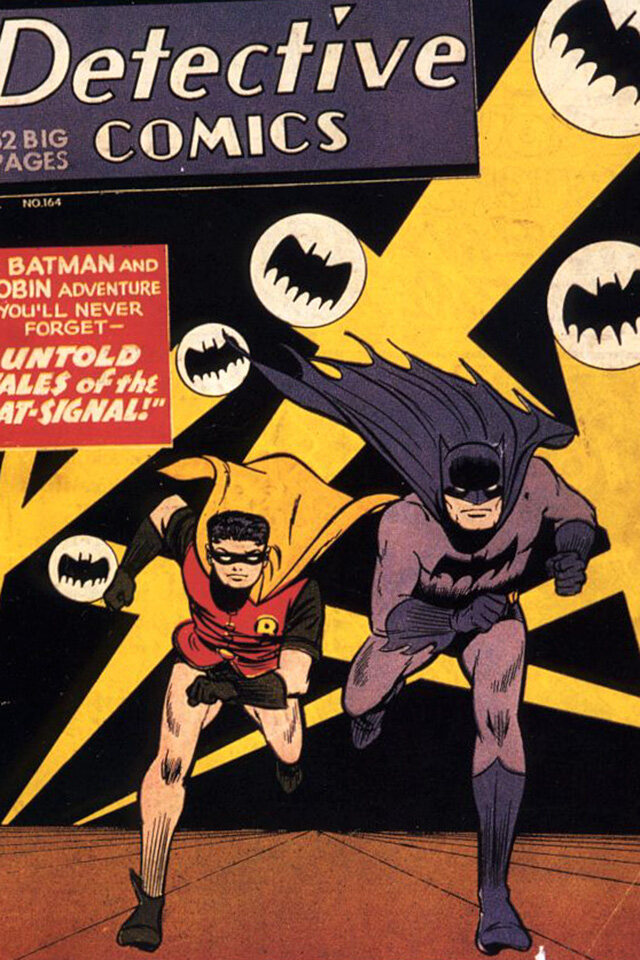I was able to further refine the concept of Medlay during my graduate thesis1, which aimed to compare the cinema and comics media forms and formulate a new creative way to crossbreed them on the Web.
Below is the main reasoning behind my thesis:
Remediation
The relationship between the two media of cinema and comics is a long story of competition and reciprocal remediation2.
The term remediation does not refer to the transposition of contents3 between cinema and comics, but rather to the reciprocal borrowing and reshaping of their media forms by both.
For example, the 1960s TV series Batman transposed the imagery and characters of the comic book of the same name. Batman, 1960s TV series.

A cover of Detective Comics featuring Batman and Robin, DC Comics, 1940. Roger Sabin, Comics, Comix and Graphic Novels—A History Of Comic Art
A practical example of remediation is the way the movie Sin City—a transposition of the graphic novel of the same name—has remediated a typical device of the comics media form: the splash page.
Through “splash pages” […] comics have the distinctive potential to convey in purely graphic terms the importance of a (literally) “big” moment in the story.
Greg M. Smith, Shaping The Maxx: adapting the comic book frame to television
Restricted by the film’s seemingly fixed, invisible frame
the movie remediates and reshapes the “splash page” device through camera movement and the artificially frozen pose of the jumping character.
Robert Rodríguez & Frank Miller, Sin City.
Digital revolution
Before the digital revolution, these reciprocal remediations were always limited by different production, recording, transmission, and reproduction technologies.
After the digital revolution, the technological differences between the two cultural forms—absorbed by the World Wide Web—have been reset. However, in most cases, cinema and comics have continued to be considered and remediated separately.
Is it possible to create a new hybrid media form that integrates the characteristics of cinema and comics that once seemed incompatible, now that the two mediums potentially differ only in their respective processes?

In my opinion, Marvel Motion Comics are not comics; their media form is, in fact, that of cartoon cinema through and through. Marvel Motion Comics, Spider Woman.
Sequential art
To assess the potential for interbreeding between the two cultural forms, cinema and comics have been subsumed under the broader concept of sequential art: the arrangement of pictures or images and words to narrate a story or dramatize an idea
—a definition created in 1985 by Will Eisner4 and expanded in 1994 by Scott McCloud5. This concept has been used to compare cinema and comics, highlighting their affinities and differences.
The comparison analyzes the following points:
- the respective procedures by which cinema and comics represent time and space, both at the level of the cinematic shot and the comics panel, as well as at the level of the sequence of shots and panels;
In the cinematic media form, time is conveyed directly through the passage of time.
In the comics media form, time is conveyed indirectly through space. Carlos Trillo & Enrique Breccia, Alvar Mayor.
- the differences between the cinema split screen and the comics layout;
- the differences between the format of the cinema shot and that of the comics panel;
- the respective procedures by which cinema and comics represent voice, noise and music;
- the respective procedures of interpretation.
Hybrid media form
The consequences of the mid-1980s digital revolution6, the emergence of the new digital media and their characteristics, and the new possibilities for producing dynamic images enabled by computers and the Web have been subsequently examined.
In the end, a new hybrid media form that integrated both cinema and comics was proposed and demonstrated: Medlay.
This hybridization was made possible by the mid-1980s digital revolution and the ever-growing, eclectic and inclusive Web environment, which serves as a melting pot for various old media forms and has increasingly become a crucial distribution channel.
If you have any suggestions or spot anything that needs fixing, please let me know. Your thoughts, critiques, and recommendations are more than welcome.
Thank you!
-
A huge thank-you to Massimo Magrì and Nicolò Scibilia for for giving me this opportunity and for their help throughout the process. ↩
-
Jay David Bolter & Richard Grusin, Remediation. ↩
-
Referring to imagery, stories, characters, …. ↩
-
Will Eisner, Comics & Sequential Art. ↩
-
Scott McCloud, Understanding Comics. ↩
-
The main consequences of the mid-1980s digital revolution were the advent of the computer, the digitization of data from analog to digital, and the progressive computerization of culture.
See Lev Manovich, The Language of New Media. ↩












